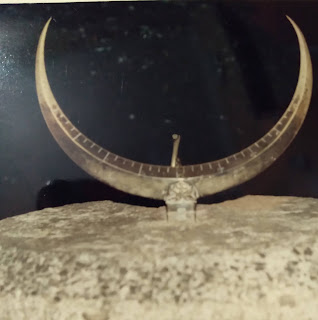HISTORIC SUNDIAL OF BARAMBA
HISTORIC SUNDIAL OF BARAMBA
Nikunja Bihari Sahu
Known for the famous temple of the goddess Bhattarika on the bank of the river Mahanadi, the erstwhile princely state of the British colonial period, Barambagarh is located nearly 84 km West of Bhubaneswar. The Baramba palace still stands in testimony to this glorified past of the royal period. . A British period sundial that adorns the Tahsil office premises of Baramba adds further to this great colonial legacy. There was a time when the device was quietly ticking away under the Sun and people, from far and near, were thronging the site for checking time , as there was no other time keeping device then available. However, things have changed a lot over the years. Time has clearly taken a toll on this tell-tale artifact of time and signs of ruin are writ large on the face of this priceless heritage. At present, a part of the device is broken leaving it in a state of defunct. The graduation marks made on the dial to display time are withered away and the pedestal that supports the device is also damaged due to ageing. Apathy by the Government and neglect due to ignorance by the locals has left the device in a state of ruins. Added to this, many tall trees growing around the device obstruct the sunlight in the sky for some part of the day that impairs the uninterrupted operation of the device. Unless urgent action is taken, the device may soon lose its importance and succumb to the onslaught of time.
Concept of Sundial
For early man, the Sun was the guide in the sky to tell time. The Sun rises in the east at dawn, climbs the sky with time and eventually sets below the horizon at dusk. Thus the changing positions of the Sun in the sky with time offer a scope to foretell time. It is easier to ascertain the time of the sunrise or sunset simply by looking at the Sun directly in the sky as it grazes the horizon. However, it is quite difficult to do so corresponding to other positions of the Sun in the sky. Man observed that the shadow of a pole cast by the Sun keeps on changing both in ‘length’ and ‘direction’ throughout the day as the Sun goes in its daily path in the sky. Hence, it was quite natural for the early man to observe the shadow of an object cast on the ground rather than looking at the Sun in the sky to have a precise measurement of time. This possibly gives rise to the concept of sundial.
A sundial is a simple instrument that consists of a staff (called the Style) to cast shadow on a graduated scale (called the Dial) indicating time. Sundials are classified as Horizontal, Vertical or Equatorial depending on the orientation of their dial planes.
The Device
The sundial of Baramba belongs to the Equatorial type where the dial is kept parallel to the Earth’s equator. For this, the dial is tilted by an angle nearly 21 degrees (equal to the local latitude) from the vertical line towards the South as the equator is located south of our place. The Style is aligned perpendicular to the dial plane in a direction parallel to the Earth’s axis, and hence, it directly points to the Pole Star in the sky in its Northward direction. As the Sun goes in its daily orbit across the sky, the shadow keeps on moving over the graduated dial indicating time.
Made of brass, the dial of Baramba device is designed into a beautiful crescent moon shape which is suitably graduated to indicate time. Each hour is divided into 4 parts and each part into further 3 divisions to indicate a minimum time span of 5 minutes. However, the Style of the dial is completely dislocated leaving the device in a non-operational state now.
Like all other sundials of the state, the Baramba sundial indicates the Local Time i.e. the time corresponding to the place of observation. However, this can be readily converted to Indian Standard Time (as indicated by a Watch) by subtracting from it a time interval of 14 minutes, as the Indian Mean longitude is located West of our meridian by an amount of 3.5 degrees and taking into consideration that each degree of longitude difference accounts for a passage of 4 minutes of time.
Construction Period
Unfortunately, there is no mention anywhere about the designer and the construction period of the sundial. In Odisha, most sundials were constructed during the British colonial period. These were mostly built by the kings and kept at public places like temples, palaces, schools and kacheries to facilitate people keep track of time. In spite of the obscurity of the historical account of the sundial, its genesis may be safely traced back to the early part of the 20th century when all other sun-dials of our state were supposedly built.
The Baramba sundial is one of the seven known historic sundials of Odisha located at Cuttack, Kendrapara, Konark, Bhubaneswar, Khandapara and Madhupur (Jajpur district). The sundials enjoyed a period of monopoly till replaced by the mechanical clocks introduced by the British brought from London.
Conservation
As the monument is one of the heritage assets of our state and represents the best scientific and technological skill of our ancestors, utmost priority should be given for its conservation and upkeep so as to bring back its lost glory. Measures should be taken to replace the dislocated Style of the sundial and to redraw the obscure hour-lines of the dial.
Instruction depicting the use of the sundial should be provided for the benefit of common people visiting the Tahsil office on their daily business. Obstructions that hinder the sunlight from casting the shadow on the dial should be cleared or the device should be re-located to a suitable place within the same premises so as to ensure its continuous operation under the sunlight.
Education Officer
Regional Science Centre
Bhopal
Further Reading
1. An article entitled “Ancient sundials of Orissa” by Shri N.B. Sahu published in Orissa Review : September- October,2005 isuue.
2. An article entitled “Time Casts a Shadow on this Sundial” by Shri N.B. Sahu published in Orissa Post dated 14.07.2013.
3. . An article entitled “Sundial” by Shri N.B. Sahu published in Science Horizon ( Odisha Bigyan Academy): October,2011 issue
4. An article in Oriya entitled "Sundial of Mukteswar Temple" by N.B. Sahu published in Bigyana Diganta (Odisha Bigyan Academy) October, 2006 issue
5. An article in Oriya on "Sundial" by Shri N.B. Sahu published in Bigyana Diganta (Odisha Bigyan Academy ) July-August,1996 issue
6. An article in Oriya on "Sundials of Orissa” by Shri N.B. Sahu published in Utkala Prasanga July, 1998 issue




Comments
Post a Comment